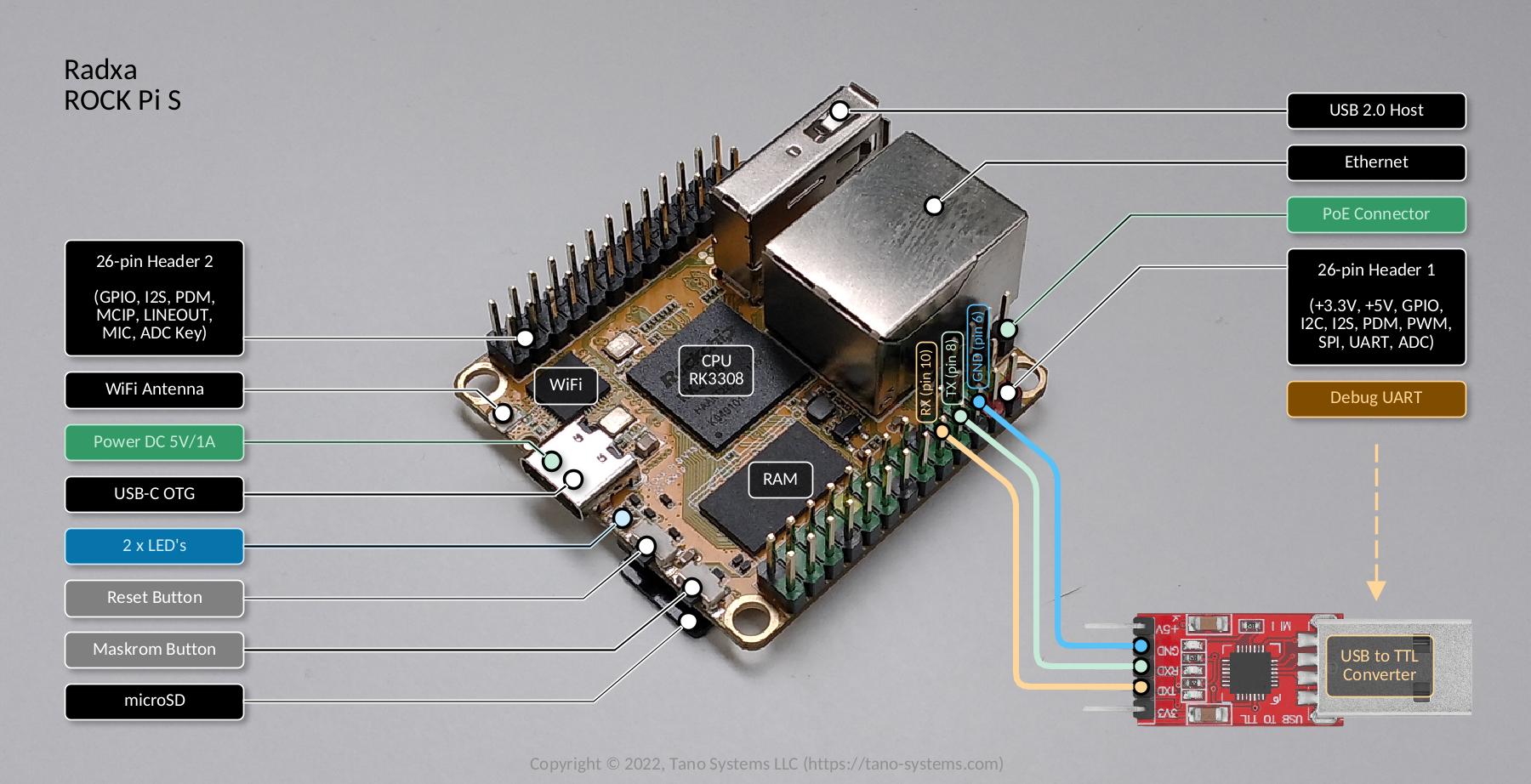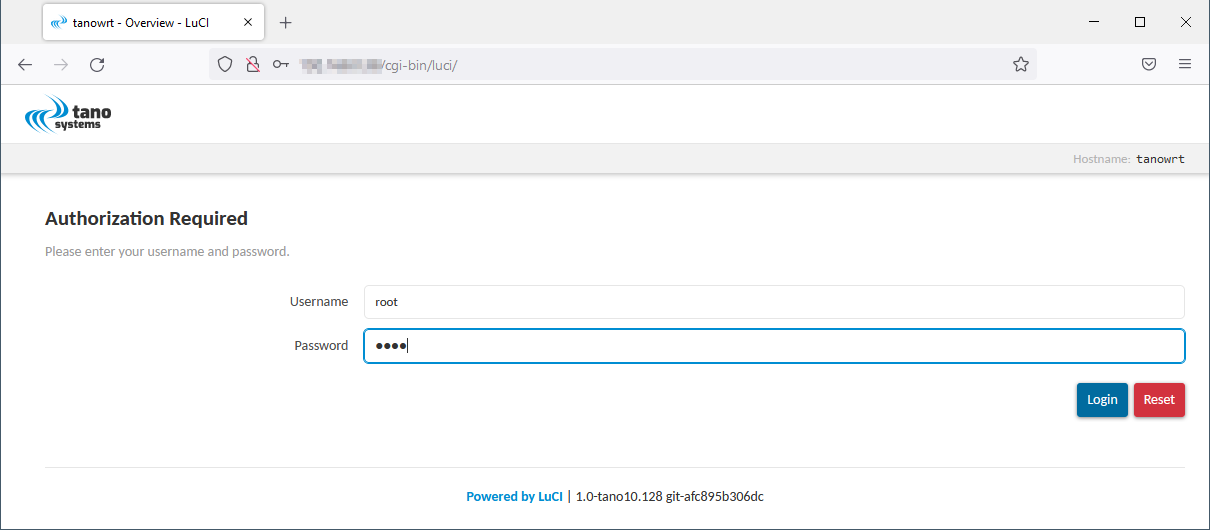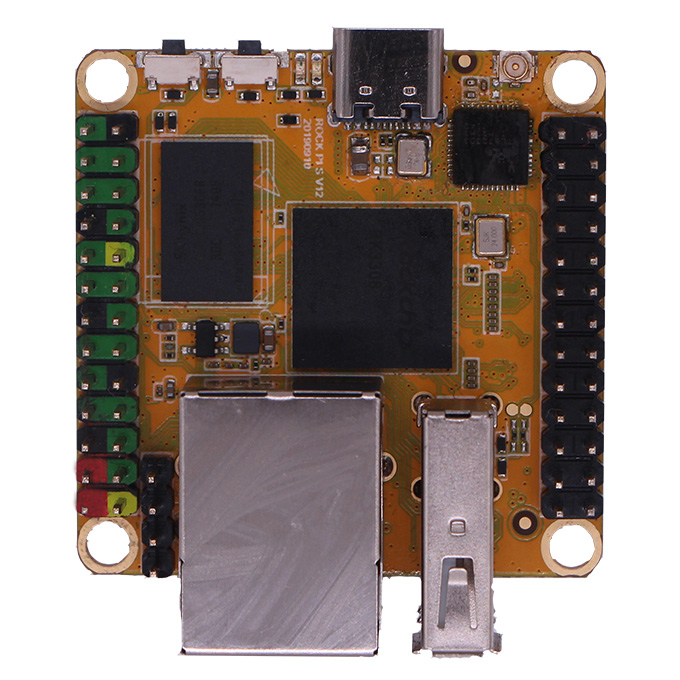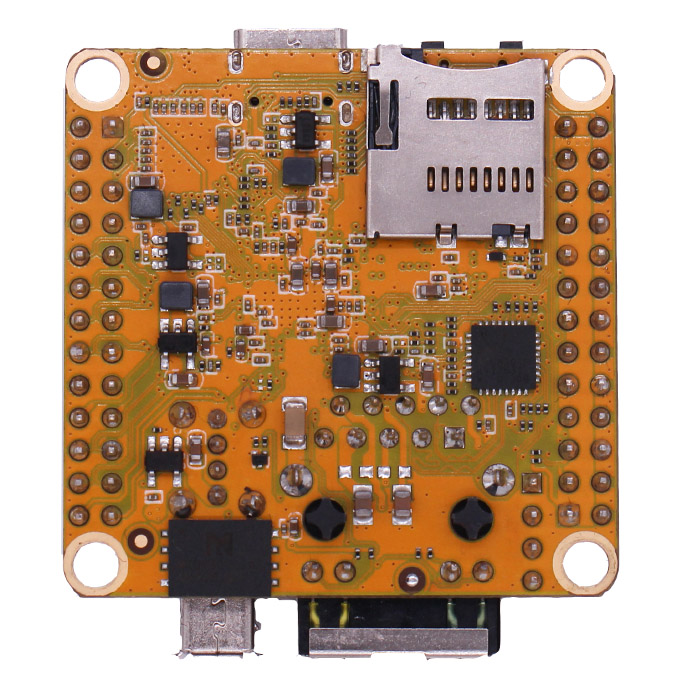3 Radxa ROCK Pi S
Contents
3.1 Board Overview
ROCK Pi S is a Rockchip RK3308 based SBC (Single Board Computer) by Radxa. It equips a 64 bits quad-core processor, USB, ethernet, wireless connectivity and voice detection engine at the size of 1.7 inch, make it perfect for IoT and voice applications. ROCK Pi S comes in two RAxM sizes 256 MiB or 512 MiB DDR3, and uses microSD card for OS and storage. Optionally, ROCK Pi S can provide on board storage version with 1/2/4/8 GiB NAND flash.

Fig. 3.8 ROCK Pi S Board
3.1.1 Photos
3.1.2 Specification
Model |
ROCK Pi S |
|---|---|
Processor |
SoC Rockchip RK3308
Quad Cortex-A35 ARM 64 bits processor
frequency up to 1.3 GHz
|
Memory |
256 MiB or 512 MiB DDR3 |
Storage |
microSD(TF)
optional on board 1/2/4/8 GiB NAND flash
|
Wireless |
802.11 b/g/n WiFi
Bluetooth 4.0 (RTL8723DS)
External antenna
|
USB |
1 × USB 2.0 Type-A HOST
1 × USB 3.0 Type-C OTG
|
Keys |
1 × Maskrom
1 × Reset
|
Ethernet |
100 Mbit/s Ethernet, optional PoE (additional HAT requried) |
IO |
26-pin expansion header
4 × I2C
3 × PWM
2 × SPI
3 × UART
1 × I2S
2 × 5V DC power in
2 × 3.3 DC power in
|
Power |
USB Type-C DC 5V |
Dimensions |
43.18 mm × 43.18 mm (1.7 inch square) |
3.1.3 Hardware Models
ROCK Pi S board comes with different versions. Not all versions are supported and tested with TanoWrt.
SKU |
RAM |
SD NAND |
WiFi/BT |
PoE |
TanoWrt Support |
|---|---|---|---|---|---|
RS308-D2 |
256 MiB |
– |
– |
– |
Yes (not tested) |
RS308-D4 |
512 MiB |
– |
– |
– |
Yes (not tested) |
RS308-D4W |
512 MiB |
– |
RTL8723DS |
– |
Yes (not tested) |
RS308-D4WP |
512 MiB |
– |
RTL8723DS |
Supported |
Yes (not tested) |
RS308-D4WPN8 |
512 MiB |
1 GiB |
RTL8723DS |
Supported |
Yes |
RS308-D4WPN64 |
512 MiB |
8 GiB |
RTL8723DS |
Supported |
Yes (not tested) |
3.2 Build Targets
3.2.1 Machines
Board[1] |
Target YAML[2] |
Machine[3] |
Target Recipe(s)[4] |
Running Media[5] |
Installation Media[6] |
|---|---|---|---|---|---|
ROCK Pi S |
|
|
|
microSD card |
– |
|
|
|
internal SD NAND flash |
microSD card |
3.2.2 Images
Image recipe name. This name can be used as argument
for --target build command option (see Section 3.3 section).
3.3 Build
Please read the common information on how to perform a TanoWrt images build and preparing the build environment in section “Building TanoWrt”.
See also
See section Section 3.2.1 to select the required target YAML file (
<target-yml>).See section Section 3.2.2 to select the required root filesystem image recipe (
<target-recipe>).See section Section 3.5 for detailed information about the produced build artifacts.
3.3.1 Examples
3.3.1.1 Build Default Images for ROCK Pi S Board
For microSD Card
$ kas build targets/kas/rock-pi-s-sd.yml
Default images will be produced to boot and run from the microSD card on the ROCK Pi S target board.
For Internal SD NAND Flash
$ kas build targets/kas/rock-pi-s-sdnand.yml
An initial factory installation image will be generated, intended to run from the microSD card. The installer image will install the default image to the internal SD NAND flash memory and further the ROCK Pi S board will boot and run from the SD NAND flash memory.
3.4 Partitioning Layouts
Images for ROCK Pi S board using default partitions layouts described here.
3.5 Produced Build Artifacts
All produced build artifacts are stored in the ~/tanowrt/build/tanowrt-glibc/deploy/images/<MACHINE> directory.
Refer to table Produced Build Artifacts for a description of some common (not all) build artifacts.
Artifact |
Target(s) |
Description |
|---|---|---|
Bootloader |
||
|
All |
Rockchip IDBLOCK image for booting from SD card. |
|
|
Rockchip IDBLOCK image for booting from internal SD NAND. |
Bootloader (U-Boot) |
||
|
All |
U-Boot startup script. |
|
|
U-Boot startup script for factory installation image. |
|
All |
U-Boot initial environment image for SD card image. |
|
|
U-Boot initial environment image for internal SD NAND flash. |
|
All |
U-Boot binary image for booting from SD card. |
|
|
U-Boot binary image for booting from internal SD NAND flash. |
Linux Kernel and DTB |
||
|
All |
Flattened Image Tree (FIT) image with Linux kernel and Device Tree Blobs (DTB). |
|
All |
FIT image packed into an ext4 file system image. |
|
All |
Target Device Tree Blob (DTB). |
Images |
||
|
|
SD card image including all required partitions for booting and running the system. This image is ready to be written to the SD card using the dd utility or similar (see Writing Images). |
|
|
SD card factory installation image. This image is ready to be written to the SD card using the dd utility or similar (see Writing Images). |
|
All |
Root filesystem image (squashfs with LZO compression). |
|
All |
Firmware upgrade image. |
Note
<MACHINE> in the artifacts path and artifact file names are replaced by
the actual value of the MACHINE BitBake variable for the chosen
target. <rootfs-image> is replaced
by the actual read-only root filesystem image name.
For example, below is the complete list of artifacts produced by the
rock-pi-s-sd.yml target build.
[~/tanowrt/build/tanowrt-glibc/deploy/images/rock-pi-s-sd]$ ls -gGh
total 184M
lrwxrwxrwx 2 84 Jun 7 06:29 fitImage -> fitImage--4.19.219+git0+40b753b965-tano1.2.20.20.1.0-rock-pi-s-sd-20220607032704.bin
-rw-r--r-- 2 3.7M Jun 7 06:29 fitImage--4.19.219+git0+40b753b965-tano1.2.20.20.1.0-rock-pi-s-sd-20220607032704.bin
-rw-r--r-- 2 5.5M Jun 7 06:29 fitImage-4.19.219+gitAUTOINC+40b753b965-tano1.2.20.20.1.0-rock-pi-s-sd.ext4
-rw-r--r-- 2 1.6K Jun 7 06:29 fitImage-its--4.19.219+git0+40b753b965-tano1.2.20.20.1.0-rock-pi-s-sd-20220607032704.its
lrwxrwxrwx 2 88 Jun 7 06:29 fitImage-its-rock-pi-s-sd -> fitImage-its--4.19.219+git0+40b753b965-tano1.2.20.20.1.0-rock-pi-s-sd-20220607032704.its
-rw-r--r-- 2 3.7M Jun 7 06:29 fitImage-linux.bin--4.19.219+git0+40b753b965-tano1.2.20.20.1.0-rock-pi-s-sd-20220607032704.bin
lrwxrwxrwx 2 94 Jun 7 06:29 fitImage-linux.bin-rock-pi-s-sd -> fitImage-linux.bin--4.19.219+git0+40b753b965-tano1.2.20.20.1.0-rock-pi-s-sd-20220607032704.bin
lrwxrwxrwx 2 84 Jun 7 06:29 fitImage-rock-pi-s-sd.bin -> fitImage--4.19.219+git0+40b753b965-tano1.2.20.20.1.0-rock-pi-s-sd-20220607032704.bin
-rw-r--r-- 2 5.5M Jun 7 06:29 fitImage-rock-pi-s-sd.ext4
lrwxrwxrwx 2 72 Jun 7 05:55 idblock.img-rock-pi-s-sd-sdcard -> idblock.img-rock-pi-s-sd-sdcard-2017.09+gitAUTOINC+e3ca3c3805_fe66a9be19
-rwxr-xr-x 2 110K Jun 7 05:55 idblock.img-rock-pi-s-sd-sdcard-2017.09+gitAUTOINC+e3ca3c3805_fe66a9be19
lrwxrwxrwx 2 71 Jun 7 05:55 loader.bin-rock-pi-s-sd-sdcard -> loader.bin-rock-pi-s-sd-sdcard-2017.09+gitAUTOINC+e3ca3c3805_fe66a9be19
-rwxr-xr-x 2 237K Jun 7 05:55 loader.bin-rock-pi-s-sd-sdcard-2017.09+gitAUTOINC+e3ca3c3805_fe66a9be19
-rw-r--r-- 2 41M Jun 7 06:29 modules--4.19.219+git0+40b753b965-tano1.2.20.20.1.0-rock-pi-s-sd-20220607032704.tgz
lrwxrwxrwx 2 83 Jun 7 06:29 modules-rock-pi-s-sd.tgz -> modules--4.19.219+git0+40b753b965-tano1.2.20.20.1.0-rock-pi-s-sd-20220607032704.tgz
-rw-r--r-- 2 63K Jun 7 06:29 rk3308-rock-pi-s--4.19.219+git0+40b753b965-tano1.2.20.20.1.0-rock-pi-s-sd-20220607032704.dtb
lrwxrwxrwx 2 92 Jun 7 06:29 rk3308-rock-pi-s.dtb -> rk3308-rock-pi-s--4.19.219+git0+40b753b965-tano1.2.20.20.1.0-rock-pi-s-sd-20220607032704.dtb
lrwxrwxrwx 2 92 Jun 7 06:29 rk3308-rock-pi-s-rock-pi-s-sd.dtb -> rk3308-rock-pi-s--4.19.219+git0+40b753b965-tano1.2.20.20.1.0-rock-pi-s-sd-20220607032704.dtb
-rw-r--r-- 2 2.2K Jun 7 11:40 startup.img
-rw-r--r-- 2 16 Jun 7 11:40 startup.img.version
lrwxrwxrwx 2 11 Jun 7 11:40 startup-rock-pi-s-sd.img -> startup.img
lrwxrwxrwx 2 19 Jun 7 11:40 startup-rock-pi-s-sd.img.version -> startup.img.version
-rw-r--r-- 2 5.1K Jun 7 12:02 tanowrt-image-full.env
-rw-r--r-- 2 53K Jun 7 12:02 tanowrt-image-full-rock-pi-s-sd-20220607090114.rootfs.manifest
-rw-r--r-- 2 945M Jun 7 12:03 tanowrt-image-full-rock-pi-s-sd-20220607090114.rootfs.sdcard.img
-rw-r--r-- 2 26M Jun 7 12:02 tanowrt-image-full-rock-pi-s-sd-20220607090114.rootfs.squashfs-lzo
-rw-r--r-- 2 24 Jun 7 12:03 tanowrt-image-full-rock-pi-s-sd-20220607090114.rootfs.version
-rw-r--r-- 2 362K Jun 7 12:02 tanowrt-image-full-rock-pi-s-sd-20220607090114.testdata.json
lrwxrwxrwx 2 62 Jun 7 12:02 tanowrt-image-full-rock-pi-s-sd.manifest -> tanowrt-image-full-rock-pi-s-sd-20220607090114.rootfs.manifest
lrwxrwxrwx 2 64 Jun 7 12:03 tanowrt-image-full-rock-pi-s-sd.sdcard.img -> tanowrt-image-full-rock-pi-s-sd-20220607090114.rootfs.sdcard.img
lrwxrwxrwx 2 66 Jun 7 12:02 tanowrt-image-full-rock-pi-s-sd.squashfs-lzo -> tanowrt-image-full-rock-pi-s-sd-20220607090114.rootfs.squashfs-lzo
lrwxrwxrwx 2 60 Jun 7 12:02 tanowrt-image-full-rock-pi-s-sd.testdata.json -> tanowrt-image-full-rock-pi-s-sd-20220607090114.testdata.json
lrwxrwxrwx 2 61 Jun 7 12:03 tanowrt-image-full-rock-pi-s-sd.version -> tanowrt-image-full-rock-pi-s-sd-20220607090114.rootfs.version
-rw-r--r-- 2 2.2K Jun 7 12:02 tanowrt-image-full-sdimage-rockchip-swu-a-b.wks
-rw-r--r-- 2 34M Jun 7 12:03 tanowrt-image-full-swu-rock-pi-s-sd-20220607090114.swu
lrwxrwxrwx 2 54 Jun 7 12:03 tanowrt-image-full-swu-rock-pi-s-sd.swu -> tanowrt-image-full-swu-rock-pi-s-sd-20220607090114.swu
lrwxrwxrwx 2 85 Jun 7 05:55 u-boot-initial-env-rock-pi-s-sd-sdcard -> u-boot-initial-env-rock-pi-s-sd-sdcard-2017.09+gitAUTOINC+e3ca3c3805_fe66a9be19-tano7
-rw-r--r-- 2 459 Jun 7 05:55 u-boot-initial-env-rock-pi-s-sd-sdcard-2017.09+gitAUTOINC+e3ca3c3805_fe66a9be19-tano7
-rw-r--r-- 2 32K Jun 7 05:55 u-boot-initial-env-rock-pi-s-sd-sdcard-2017.09+gitAUTOINC+e3ca3c3805_fe66a9be19-tano7.bin
lrwxrwxrwx 2 89 Jun 7 05:55 u-boot-initial-env-rock-pi-s-sd-sdcard.bin -> u-boot-initial-env-rock-pi-s-sd-sdcard-2017.09+gitAUTOINC+e3ca3c3805_fe66a9be19-tano7.bin
lrwxrwxrwx 2 85 Jun 7 05:55 u-boot-initial-env-sdcard -> u-boot-initial-env-rock-pi-s-sd-sdcard-2017.09+gitAUTOINC+e3ca3c3805_fe66a9be19-tano7
lrwxrwxrwx 2 89 Jun 7 05:55 u-boot-initial-env-sdcard.bin -> u-boot-initial-env-rock-pi-s-sd-sdcard-2017.09+gitAUTOINC+e3ca3c3805_fe66a9be19-tano7.bin
lrwxrwxrwx 2 64 Jun 7 05:55 u-boot-rock-pi-s-sd.bin -> u-boot-sdcard-2017.09+gitAUTOINC+e3ca3c3805_fe66a9be19-tano7.bin
lrwxrwxrwx 2 64 Jun 7 05:55 u-boot-rock-pi-s-sd.bin-sdcard -> u-boot-sdcard-2017.09+gitAUTOINC+e3ca3c3805_fe66a9be19-tano7.bin
-rw-r--r-- 2 2.0M Jun 7 05:55 u-boot-sdcard-2017.09+gitAUTOINC+e3ca3c3805_fe66a9be19-tano7.bin
3.6 Writing Images
3.6.1 Writing Image to microSD Card
No special information about writing images to microSD card for ROCK Pi S board. See common instructions in Writing Images to SD Card or USB Flash Drive section.
Examples
Writing factory installation image for the rock-pi-s-sdnand.yml target to the microSD
card /dev/mmcblk1:
$ dd if=tanowrt-image-full-swu-factory-rock-pi-s-sdnand.sdcard.img of=/dev/mmcblk1
Writing bootable image for the rock-pi-s-sd.yml target to the microSD
card /dev/mmcblk1:
$ dd if=tanowrt-image-full-rock-pi-s-sd.sdcard.img of=/dev/mmcblk1
3.6.2 Writing Image to SD NAND Flash
For the initial flashing of the internal SD NAND memory it is recommended to use
the special image of the initial factory installation. If you choose a build target
(see Build Targets for details) that assumes using the
factory installation image for the initial flashing of the
device, a factory installation image (<rootfs-image>-swu-factory-<MACHINE>.sdcard.img)
will be automatically generated during the build process
(see Build).
To write the factory installation image to an SD card, follow the instructions
from Writing Images to SD Card or USB Flash Drive section.
When you boot device from the prepaired SD card with factory installation image the installation of TanoWrt to the internal SD NAND flash memory will be done automatically. The detailed installation log is available on the debug UART. After the installation is complete, the board will shut down automatically. When the device is turned on, the installed system will be booted from the internal SD NAND flash memory.
Caution
Be aware that during the installation all existing data on the internal SD NAND flash memory will be permanently lost.
3.7 Booting and Running
3.7.1 Booting from SD Card
Insert the micro SD card to the board.
Use a USB Type-C to USB Type-A cable, connect the board to your PC.
ROCK Pi S will boot, the green power led is on, and after a while, the blue led start blinking.
(Optional) Use a USB to TTL serial cable to make a connection between your PC and ROCK Pi S. See Serial Console section for details.
Log in to system using default credentials.
Attention
The internal SD NAND flash memory must be empty in order to perform a boot from the SD card. See Erasing Internal SD NAND Flash section for details about erasing internal SD NAND flash.
3.7.2 Booting from Internal SD NAND Flash
Use a USB Type-C to USB Type-A cable, connect the board to your PC.
ROCK Pi S will boot, the green power led is on, and after a while, the blue led start blinking.
(Optional) Use a USB to TTL serial cable to make a connection between your PC and ROCK Pi S. See Serial Console section for details.
Log in to system using default credentials.
3.7.3 Erasing Internal SD NAND Flash
You can erase the internal SD NAND flash memory in the following ways:
Linux command line;
U-Boot command line;
special utilities and USB connection with PC.
Erasing SD NAND Using Linux Command Line
If the device has a bootable Linux system, you can erase the SD NAND by the following command entered in the Linux terminal:
[root@tanowrt ~]# dd if=/dev/zero of=/dev/mmcblk0 bs=1k count=32768
Note that if the Linux distribution flashed on the SD NAND flash memory is not TanoWrt, the device name of the SD NAND flash memory may be different. You can usually find out the real device name by analysing the system boot log by running the command dmesg. For example:
[root@tanowrt ~]# dmesg | grep mmcblk
[ 0.829147] mmcblk0: mmc0:21c9 XTSDA 990 MiB
[ 0.840930] mmcblk0: p1 p2 p3 p4 p5 p6
[ 5.025192] mount_root: /dev/mmcblk0p1: p1, rw, start 8388608, size 8388608
[ 5.033574] mount_root: /dev/mmcblk0p2: p2, rw, start 16777216, size 50331648
[ 5.034476] mount_root: /dev/mmcblk0p3: p3, rw, start 67108864, size 310378496 [rootfs]
[ 5.042884] mount_root: /dev/mmcblk0p4: p4, rw, start 377487360, size 50331648
[ 5.045888] mount_root: /dev/mmcblk0p5: p5, rw, start 427819008, size 310378496
[ 5.054576] mount_root: /dev/mmcblk0p6: p6, rw, start 738197504, size 298844160 [overlay]
[ 5.055393] mount_root: root filesystem on the /dev/mmcblk0p3 partition of /dev/mmcblk0 (rw) device
[ 5.083521] mount_root: founded suitable overlay partition /dev/mmcblk0p6
[ 5.847535] EXT4-fs (mmcblk0p6): recovery complete
[ 5.849379] EXT4-fs (mmcblk0p6): mounted filesystem with ordered data mode. Opts: (null)
[ 5.892056] EXT4-fs (mmcblk0p6): mounted filesystem with ordered data mode. Opts: (null)
[ 13.972921] mmcblk1: mmc1:aaaa SS16G 14.8 GiB
[ 13.987047] mmcblk1: p1 p2
This output shows that device /dev/mmcblk0 is SD NAND flash
memory and device /dev/mmcblk1 is SD card.
Erasing SD NAND Using U-Boot Command Line
If the device has a functional U-Boot bootloader, you can erase SD NAND with the following commands entered at the U-Boot command line:
=> mmc dev 0
switch to partitions #0, OK
mmc0 is current device
=> mmc erase 0 10000
MMC erase: dev # 0, block # 0, count 65536 ... 65536 blocks erased: OK
=>
Please note that if the U-Boot bootloader on the SD NAND flash memory is different from the one built as part of the TanoWrt distribution, the device number of the SD NAND flash memory may be different from the one shown above. Use the mmc dev, mmc list and mmc info commands to identify the valid SD NAND flash memory device number:
=> mmc dev 0
switch to partitions #0, OK
mmc0 is current device
=> mmc info
Device: dwmmc@ff490000
Manufacturer ID: b
OEM: 5854
Name: XTSDA
Timing Interface: Legacy
Tran Speed: 52000000
Rd Block Len: 512
SD version 2.0
High Capacity: No
Capacity: 990 MiB
Bus Width: 4-bit
Erase Group Size: 512 Bytes
=>
Erasing SD NAND Using Special Utilities and USB Connection with PC
If the device fails to boot, e.g. due to a corrupted boot loader, the only way to erase the SD NAND flash memory is to use a USB connection with a PC and use special utilities. To do this, follow these instructions from the official Radxa wiki page.
3.8 Serial Console
Note
The default baudrate of ROCK Pi S is 1500000 (1.5 Mbps), please check if your USB to TTL cable support 1.5 Mbps baudrate. Some model of CP210X and PL2303x have baudrate limitation, please check the specified model.
Connection
Connect the USB to TTL serial cable as described below. Don’t connect the VCC wire, connect only TX, RX and GND wires.
Signal |
ROCK Pi S Board |
|
|---|---|---|
V1.0 |
V1.1 and later |
|
RX |
Pin 9 |
Pin 10 |
TX |
Pin 11 |
Pin 8 |
GND |
Pin 25 |
Pin 6 |
See Fig. 3.8 for example connection USB to TTL converter with ROCK Pi S V1.1 or later.
Serial Setting on Host PC
The default serial setting for ROCK Pi S U-Boot and kernel console is:
baudrate: 1500000
data bit: 8
stop bit: 1
parity: none
flow control: none
3.9 Default Network Configuration
By default Ethernet port (eth0 interface) are joined into a bridge (br-lan interface).
Bridge (br-lan) configured to obtain IP configuration via DHCP client.
To see obtained IP configuration use the following command:
[root@tanowrt ~]# ifstatus lan | jsonfilter -e '@["ipv4-address"][0].address'
192.168.0.38
In this example, the device got the IP address 192.168.0.38 via DHCP.
Also you can connect to the board using USB network connection (usb0 interface).
USB network interface configured with static IP address 192.168.128.1 with enabled
DHCP server with pool with single IP address for client (your PC) 192.168.128.100.
WiFi module RTL8723DS currently is not supported in TanoWrt.
3.10 Web User Interface
The WebUI can be accessed via Ethernet port or USB network connection through HTTP(s) protocol. You must see something like this in browser after you logged in:

Fig. 3.11 LuCI WebUI Login Page

Fig. 3.12 LuCI WebUI Overview Page
3.11 Firmware Upgrade
No special information about firmware upgrade.
Use produced .swu artifact for upgrading running system.
See also
See common instructions in Firmware Upgrade section.
3.12 Additional Information
Here are sections with various additional information about the Radxa ROCK Pi S board and the operation of TanoWrt on it.
3.13 References
ROCK Pi S (https://wiki.radxa.com/RockpiS)
GPIO Pinout for ROCK Pi S (https://wiki.radxa.com/RockpiS/hardware/gpio)

